The US Navy accepted delivery of the future USS Tripoli, the newest aircraft focussed America class amphibious assault ship, from Huntington Ingalls Industries.
Amphibious assault ships project power and maintain presence by serving as the cornerstone of the amphibious ready group or expeditionary strike group. These ships transport elements of a US Marine expeditionary unit or expeditionary brigade with a combination of aircraft and landing craft.
Unlike vessels to be built after her, the Tripoli and her sister America have been designed with the well deck removed to allow more room for aircraft and aviation fuel. Many have likened these vessels to ‘light carriers’ or ‘Mini F-35 carriers’.
The removal of the well deck for landing craft allows for an extended hangar deck with two significantly wider high bay areas, each fitted with an overhead crane for aircraft maintenance.
Optimised for aviation capability, Tripoli will enhance US Marine Corps aviation with an enlarged hangar deck, greater maintenance capability, and JP-5 fuel capacity.
“On behalf of the entire team, I am grateful to take delivery of this versatile warfighting asset,” said Tom Rivers, amphibious warfare program manager for Program Executive Office (PEO) Ships.
“The Navy and industry team has worked persistently to deliver this platform, ready to integrate the Marine Corps air combat element, including the Joint Strike Fighter, to our combatant commanders.”
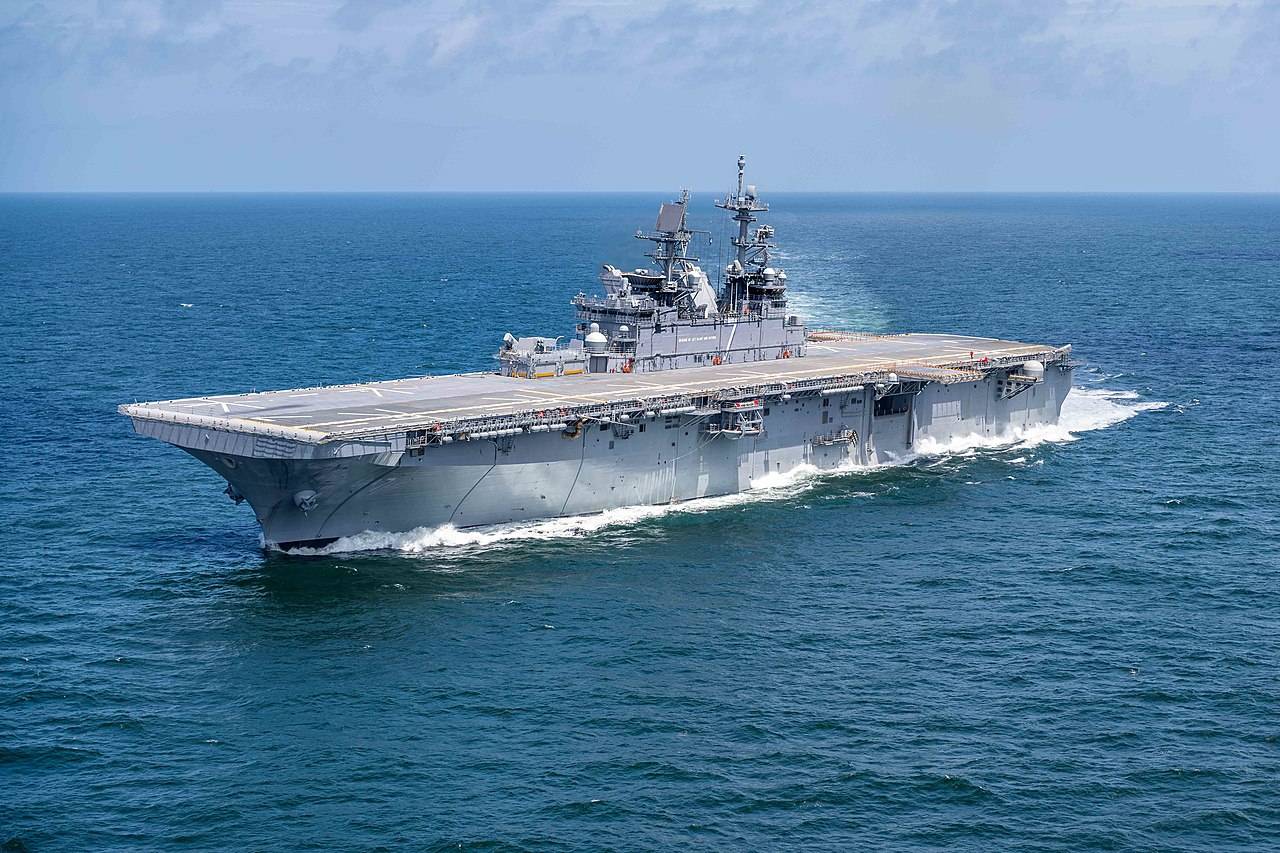
LHA 7 incorporates the fuel efficient gas turbine propulsion plant, zonal electrical distribution, and electric auxiliary systems first installed on USS Makin Island, say the builders.
“LHA 7 will be 844 feet in length, will have a displacement of approximately 44,971 long tons, and is capable of operating at speeds of over 20 knots.”
With Tripoli delivered, the ship will focus on moving crew aboard and preparing for commissioning and sailaway later this year.



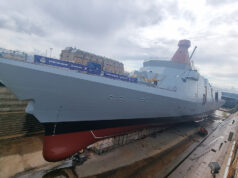
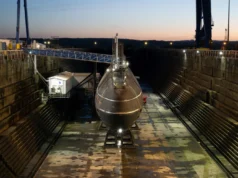

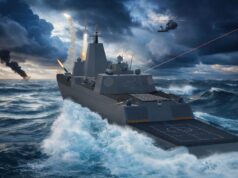
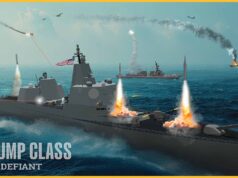
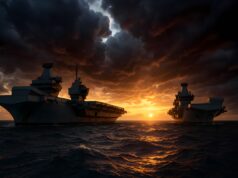
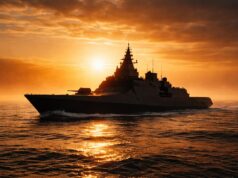

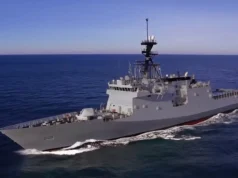

Only the US can call these mini carriers lol. For every other nation they’re full blown carriers.
Yeh, looking at Wikipedia USS Tripoli is a couple of thousand tons heavier than the Charles de Gaule! Interesting development for the USMC / USN.
You’d think they would add a ski ramp to increase weapon load if this is an F35B carrier. We could maybe do a deal to pass on some of the QE class tech.
Given that there is a Ski-jump already installed in the US to test the F-35b for UK operational doctrine I suspect the US already have all of the necessary technical capability. The only thing that appears to be stopping the deployment of smaller carriers in the USN is the political risks associated with the effective deployment of smaller, cheaper vessels. Why do you need big nuclear powered aircraft carriers, when you can use smaller cheaper ones? Not an easy question to answer, despite all of the historical support for big ships, because to be fair past performance is no guarantee of future effectiveness…
This has to be understood in the context of US Congressional budgetary power. As I understand it, and I am willing to be corrected here, the USN as never been particularly bought into the Littoral Combat Ship concept, but that did not stop powerful members of congress pushing the budget onto the Navy. So I guess the USN does not want to give any future self appointed naval expert in congress the excuse to push somehing onto them that they don’t want or need?
The problem as I see it is that because of the USN’s justified concerns with regards to unwanted (and expensive) programmes being foisted onto them, they may be missing a trick. I suspect that for the sake of a couple of big Fleet Carriers (or perhaps being able to spend the money that has been wasted on the Zumult Class that US may be capable of deploying quite a few smaller F-35b carriers. If the America Class hull was evolved into true aircraft carrier design I could see them being able to deploy half a dozen or more Charles de Gaulle size carriers in addition to 9 or 10 Fleet Carriers! That would allow them to rapidly expand the number of decks and demonstrate US industrial capabilities – rather as the British did in the run up to WW1 with a surge in dreadnaught construction.
I think a lot of eyes are looking at the viability of CVNs right now, both within and without the USN. It’s interesting that the latest testimony by the acting U.S. Navy Secretary is fairly noncommittal about the procurement of more GRF class beyond the 2 ordered under the multi hull buy (Enterprise and Miller). I posted this link in another discussion but reading into it, I stand by my opinion that we may never do a one for one replacement buy of the GRFs.
https://news.usni.org/2020/02/28/secnav-modly-says-nation-needs-larger-distributed-fleet-of-390-hulls
Cheers!
Hi Helions,
An interesting article, thanks.
Two things jump out at me. Firstly, Modly’s final statement that he is not concerned about the survivability of CVN’s in battle, rather that they may not survive fiscally, “we can only afford so many of these.”
To me that suggests a different force mix, don’t give up on big ships they are more survivable and pack a huge punch, but support them with smaller vessels that can operate differently and allow greater dispersion of forces.
The other thing that struck me was the suggestion of a move towards smaller vessels, which I took to refer to the escort fleet. The article was not clear about whether that was a wholesale move away from large capable ships such as the Arliegh Burke Class or a move to a more balanced force mix. Again, based on Royal Navy experience with small escorts, I would hope a mix.
Post WW2 the Royal Navy found itself with a large number of wartime destroyers that were relatively small and rapidly becoming obsolete as Soviet submarines improved. The stop gap answer was to convert some of them into single role ASW escorts and by single role I really mean single role! Two Limbo mortars and sonar backed up by just 2x 40mm AA guns and radar! These small specialised vessels served the RN well and the RN ASW task groups gained an enviable reputation within NATO. However, they were very, very specialised which in the context of the time was not such a problem.
Today the strategic situation is very different and changing fast and in ways that are increasingly difficult to anticipate. As we often say on here, steel is cheap and space free. Bigger ships are proving more adaptable and adaptability is important as the limited scope for updating the Type 21 frigates taught the Royal Navy. So I hope the USN goes for a mix of big capable ships that can undertake a range of roles well, and a number of smaller vessels that can be potentially be re-roled to do a single role well enough to act as force multipliers.
Certainly NATO allies have a real challenge with regards to cost, procurement process and meating the emerging threats. We live in interesting times!
Cheers CR
You’ve posted some thought provoking stuff on this thread CR (over a couple of posts…. so far… thank you). I think the ‘fashion’ is for the larger platforms and I totally get the logic for that, especially if we can ‘lean man’ them due to advances. The UK is trying the 31’s as a different approach, still going with as much ‘general purpose’ as they can, we can’t really specialise on these cheaper platforms as we don’t have the numbers but the US might.
Its just a pity that we can’t do more ‘multi buy deals’ with other countries, for whatever reason we all seem to want to ‘pimp’ them in different directions, even the French/Italian FREMM’s are basically different ships in a common hull.
Hi Andy,
‘Pimp’ made me smile, but sums it up perfactly 🙂
Everyone wants to go their own way for two basic reasons. The first is political in nature, namely, maintaining their own defence industries for high tech jobs but also it is seen as contributing to maintaining national independence. Then there are often operational differences. There was an article on here about the Italian Navy being bigger then and Royal Navy (allegedly). The article explained the misconceptions around the relative capabilities by highlighting that the Italian Navy is very Mediterean focus, able to deploy out of threat from time to time. The Royal Navy, however, as for the last 400 years had a global outlook. This difference in doctrine and operational requirements has a significant impact of platform design and the systems fitted to them.
The French also have a global view but they have a number of oversea sovereign territories that it has to protect, whereas the Royal Navy has to reasure a number of self governing dependencies. So the French have a number of ‘second’ tier patrol frigates, whereas the Royal Navy up until now have focused on high end escorts.
These differences have significant impacts on how nations see their responsibilities on the international stage so they will get quite bolshie about their requirements from time to time. The down side is that it all gets rather expensive rather quickly…
Excellent points CR! We did much the same with our wartime destroyer force with the FRAMM I and II modernization programs during the 60s. I’m looking forward to the USN’s decision on the FFGX – It’s been pulled forward and is expected in the next couple months. If you can get 2/3s of the capability of an AB for half the price. It’s a no brainer IMHO to max the numbers out there and cut back on DDGs.
Cheers
Hi Helions,
I used to have 3 books that cover the main equipment of the worlds armed forces as a kid. One for each branch, with a brief of the main powers. There were loads of pictures and lots of detailed notes on the equipments and the FRAMM ships figured in many navies back in the 70’s. I always thought they looked really cool. The difference between the RN destroyers and USN destroyers perfectly reflecting the difference in operational requirements. Big ships for the Pacific with plenty of AA guns and smaller number numerous ASW focused ships for the Battle of the Atlantic…
As for 2/3 of the capability for 1/2 the price – yup, definately a good idea, as you suggest some high end ships continue to be included in the mix. It also increases fleet flexibility in peace time allowing more hulls to be deployed more widely just to let everuone know we’re interested and watching.
Cheers CR
It was a big program and some of the vessels operated in foreign navies until fairly recently. There was a lot of emphasis on ASW as well after WWII as the threats changed.
https://en.wikipedia.org/wiki/Gearing_class_destroyer
Cheers!
Just read the other day that the US Navy added around a thousand sailors to their battleships going to the Pacific later war, just for anti Aircraft duties against Kamikazes. You can see why thy might have a big ship mentality when the Pacific is your playground rather than the Atlantic.
Yeh, the USN managed to adapt remarkedly quickly. Churchill was entirely justified to put his faith in the New World. Remarkable national achievement for the USA.
HMS Nelson and Rodney spent quite a bit of time escorting Malta convoys and one of them came back from a refit in the US with dozens of extra AA guns. I have seen a picture somewhere of the superstructure and the quarterdeck and it was like looking at a forest there were so many barrels sticking up!
Bearing in mind that most Navies didn’t think aircraft could sink a moving Battleship before the war started, it was quite a change!
It is this type of lesson from history that should warn us not to put all our eggs in one basket IMO…
I believe any aircraft attacking the refitted Nelson class battleships would be looking down 148 barrels in total!!
Hi Sean,
148!!! Seriously! They weren’t even that big as WW2 battleships went. I bet a few fillings fell out when that lot opened up!
Like I said Malta conveys. The RN took some very heavy losses fighting that battle alone and mostly to air power. Also both Nelson and Rodney were earmarked for D-Day and I bet the during 1943 planning the allies expected a far more powerful Luftwaffe response than actually materialised.
Yes 148, when you count up all the double and four barrel units that were shoe-horned aboard the Rodney after its refit Stateside after it’s demolition of the Bismarck.
Fillings probably already at risk when she fired all 9 of her 16” guns together: which happened at least once against the Bismarck. Certainly it could cause concussion if you were still in the areas beneath the guns that were meant to be evacuated during combat.
As Treaty battleships they weren’t the biggest but they were cleverly designed and packed the biggest punch in the RN. It’s a shame that neither Rodney or Warspite were preserved after the war given their records.
Hi Sean,
I read that Rodney split a number of seams under the weight of her broadsides. The process has a technical name that I cannot remember, but it was not uncommon for rivetted battleships. One of the resulting leaks was quite severe and the crew ended up making welded repairs that were never replaced by a dockyard. I understand they opened up again later in the war.
Also, Battleships could do a lot of damage to themselves when firing across the decks or on extreme bearings e.g. X and Y turrets firing on forward bearings – would not want to be on the upper deck with four 15″ guns blasting on a forward bearings!
I agree with the idea that we should have preserved one of our battleships and Warspite is my favourite, as a US commentator I read pointed out, wherever there was trouble Warspite tended to be there! She had an amazing record! I would also like to suggest Ramilles. She was pretty much as she was in WW1 and played an active part in WW2. She deterred Scharnhorst and Gneisenau from attacking a convoy she was escorting, but her most impressive contribution was during D-Day. She fired just over 1000 15″ rounds during the campaign, requiring her guns to be swapped out, and single handily held up an entire Panzer Division threatening the British flank as they advanced on Caen. She achieved this by getting so close to the shore she came close to grounding herself and firing 15″ rounds at random intervals into the approaches to the only bridge the Germans could use to attack the British. She kept shooting long enough to allow reinforcements to come up and secure the bridge.
The following link (possibly ships log extracts) indicates that she shelled 200 tanks near Caen on the 11th June. I can’t remember where I read the details… (getting old, soorry).
https://www.naval-history.net/xGM-Chrono-01BB-HMS_Ramillies.htm
When Rodney fires broadsides it apparently broke every plate, glass, etc for decks. Originally it also used to blow out all the bridge windows until they fitted blast deflectors.
Perhaps one of the most amazing things about the Bismarck incident was that she was clapped out and heading for a refit when Hood was sunk. She pulled a u turn and sped back across the Atlantic exceeding her original design speed and correctly guessing – unlike KGV – Bismarck’s direction.
I’d choose Rodney to preserve partly because of sinking the Bismarck, but also because her design best illustrates the sheer brutal power of a battleship. But yes I’d choose Warspitd too, partly as a WW1 representative and because I think she had the highest battle honours if WW2.
If you’re not aware already, I can recommend the “drachinifel” channel on YouTube. He’s a naval historian who does 5 minute guides on warship classes, individual ships, or battles. Hilariously his 5 minute guides always overrun way longer, some of his specials can be an hour or more!
(He too relates the stories too about British battleships upsetting panzer divisions on D Day, with near misses being powerful enough to blow a panzer up into the air and land upside down!)
@CR – The “move towards smaller vessels” isn’t just escorts, the USMC Commandant made a similar statement wrt the large amphib vessels. I’d also hesitate to say its “a move” as that implies moving away entirely from larger vessels and I doubt that is the USN plan, at least in the short to medium term. It is simply a recognition of the increasing threat to large vessels, that hasn’t existed before in recent times, and the desire to spread the risk, in part by developing larger numbers of smaller ships, capable of performing similar roles.
Indeed in the SECDEF’s letter he explicitly stated “At the same time, the character of maritime warfare is changing rapidly. Technological advancements in space, cyber and long range missiles increase the potential for adversaries to track, target and threaten our ships, as well as other joint platforms.”
What in particular is exercising minds is the increasing threat to naval vessels from ballistic missiles that are much harder to defend against.
Hi Glass Half Full,
I take it your an optimist 🙂
I am aware of the ballistic missile threat and I agree it is potentially very significant. Making ships smaller and stealthier, plus lots of other counter measures will help is certainly part of the mix. However, a mixed fleet will also allow the carrying of bigger SAM’s capable of engaging ballistic missiles earlier and of course it will be necessary to get the radars as high as possible to give the earliest possible warning.
Some may argue that a smaller radar picket ship deployed at distance would provide early warning, but I suspect that any vessel deployed in that role would have a very exciting if short life… UAV’s are also touted as a solution, but they are still in the future as far as deployed fleets (possibly near future for the USN) are concerned but do promise to provide useful additional capabilities.
The problem is all of these ideas are untested and I suspect few will fully live up to the sales blurb once the muck hits the fan. I am a natural optimist myself, but when it comes to over reliance on new tech to provide get out of jail free cards for procurement decision makers, I’m something of a pessimist. Why? Because I trained as an engineer and worked as a MOD techie for a number of years and I know the technology has limits and few non-tech trained people really understand those limits – especially politicians with classics degrees!
This is why I will usually come out in favour of a balanced force mix. In the RN’s case that means a few T45’s upgraded with BMD Aster 30, T26 and T31 with as many Sea Ceptors as they can cram in to deal with fast sea skimmers – layers, layers, mix, mix… I’m boring like that! Oh and lets not forget the F-35’s hopefully knocking the threat out before it launches… Actually that’s not a bad little force mix!
Hi CR. Actually chose the screen name because of the constant negativity about UK defence, here and elsewhere.
Off topic, but you kinda asked about my optimism 🙂 Fact is the UK cannot entirely dig itself out overnight from 2 decades of peace dividend under-spending, followed by a decade of Great Recession recovery, while in parallel carrying the costs of fighting in Iraq/Afghanistan. Constant discussion about ~2% of GDP spending limits is IMO irrelevant and frankly boring. Shifting CASD spend elsewhere doesn’t mean Defence gets to still keep the same budget, it would reduce commensurately because NATO would still capture CASD within defence spending, regardless of where the UK put it. Similarly demanding more be spent without defining what else gets cut is an equally fruitless exercise. It should be acknowledged, however, that defence woes are certainly compounded by some poor spending and financing decisions and/or lack of any decision. All that said the UK doesn’t fight alone and certainly not against a peer adversary.
I do think there is a danger in being too wedded to past methods and solutions, which is why I tend to support and promote more flexible and less traditional approaches, particularly when budget constrained. In addition, the adversary always has a say, which means they don’t have to fight the way we want or expect them to; as with stocks, past performance is not indicative of future results.
No argument from me about a balanced force. Once T26 is part of the mix we may also see CEC added to it, T45 and the carriers, to more effectively leverage T45 and F-35 sensors. In my view, adding CEC would make more sense than adding MK41 to T45 for example, when we have a fleet that can leverage the former.
Regarding ballistic missiles, we cannot assume 100% success in defeating all incoming missiles, including manoeuvring variants. A single hit from a BM is likely to be a ship killer due to the massive amounts of energy involved and damage caused. Hence the smaller platform approach in greater numbers that the US are discussing. This is especially relevant for ships whose mission involves slow or stopped-in-the-water operations.
The USN is clearly further advanced in countering BM threats than European navies. Currently it seems European navies will be able to detect and track ballistic missiles using either SMART-L/S1850M or an upgraded SMART-L MM radar from Thales, based on Formidable Shield exercises over the last few years. However, only those with the latest SM-6 would seem to be likely to have some ability to intercept a BM in the terminal phase. Some also appear to be considering SM-3 for exo-atmospheric defence but at an eye-watering circa $20M per missile no one in Europe seems to be racing to purchase just yet. Which leaves us with Aster 30 Block 1 NT and Block 2 BMD rolling out over the next decade, the latter likely requiring strike length MK41 or Sylver A70 VLS.
Sorry I’ve wittered on too long 🙁
Hi Glass Half Full,
Sorry for the slow response wanted to think about what you wrote – nice reason for the screen name by the way.
Firstly, nice summary of woes that have hit defence spending over the last 30 years, when listed like it is hardly surprising that we are where we are…
As for being wedded to past ways of doing things, as an engineer and former researcher I’d tend to agree, but I caution about ignoring the lessons of the past – history repeats because we forget or ignore. Fortunately the RN has not forgotten the lessons of Jutland or the Falklands as is still very strict about ammunition standards and handling and fire fighting equipment and training on board is very, very good.
My experience is that behaviours is the single biggest reason for procurement fails. Service personel will not stop changing the requirements and specifications for equipment that is supposed to be in the detailed design or worse production phase. Some of the attitudes I have encountered over the years would leave any reasonable person speechless! That, the lack of political will and sensible strategic guidance and the usual issues with contractors and you have the perfect storm for utter fail with many projects. This article on The Thin Pinstriped Line discusses the latest NAO report on the MoD’s efforts… Dismal reading I’m afraid:
https://thinpinstripedline.blogspot.com/2020/02/the-nao-report-on-mod-spending-bad-news.html
The point about ‘efficiencies’ being achieved, I actually heard senior military officers saying that efficiencies would made in the future as justification for spending now, with NO indication of what or how the efficiencies would be achieved. As a junior techie I said nothing but was not encouraged. Seems they are still waving the un-magic wand with the same results…
Hi CR.
Funny that you mentioned learning lessons. Just the other day I was thinking that a good guiding principle should be to retain all the lessons on what went wrong in the Falklands (and elsewhere), but question very hard whether what went right is still relevant in a rapidly changing combat environment. Partly because there are very different weapon capabilities today, partly because others can learn lessons too. Early on in my career someone berated me for assuming a situation, I hadn’t, but the lesson stuck nonetheless.
Interesting experience. Agree with your points in that paragraph. Continuing spec. creep and particularly an attitude that you can do anything with software, may be the highest drivers of project cost overruns anywhere.
I suspect some of the can kicking is in the hope that exchange rates improve significantly to mitigate the budget hole later in the decade. Ironically, the Army probably does have options for efficiencies. I wonder if we’ll see a thinning of numbers in the senior ranks similar to recent Navy plans and consigning of any cap badges to history. Probably not.
The LCS program was a classic example of congress pork barrel politics. The USN never wanted them but Congress kept voting funds for them , end result 27 LCS that have no definable purpose, virtually non existent fighting ability and have never been deployed but cost $30 billion to build and maintain so 4 congressional members kept there seats .
Like wise with the nuclear carriers the navy by law are committed to 12 but actually lack the funding meaning other parts of the fleet are suffering to maintain the numbers .
The USN has several serious problems at the moment due to Congress playing politics.
Hi Andy,
Hmm, your points about political interference in what is in effect the operational force structure of the USN is seriously depressing even for me as a Brit. I’ll assume you are American for the moment, if that is not case then I’ll apologise now.
The situation is not dissimilar in the UK in that Members of Parliament (PM’s) can lobby for defence £’s to be spent in their constituency, but they cannot veteo spending plans or force any Government Department into certain projects that benefit their constituency. Only the Cabinet can make those detailed decisions. Parliment does vote on the complete annual spending plan, not on individual projects.
None of which prevents politics entering into the decision making process, but that is to be expected. The problem is democratically elected politicians cannot see beyond the next election, which is hardly surprising given that politicians are the only employed group of people I can think of who can and do get sacked even if they are doing a good job! It is not a recipe for effective long term strategic thinking / planning that we so desperately need around Defence pretty much across the whole of NATO.
Not worrying about loosing their job allows the Chinese leadership to play the long game and they’re very, very good at it. Each new leader gets to build on the achievements of their predecessor – scary for us in the West, or should be.
Not so optimistic I’m afraid, CR. 🙂
How department spending is decided in USA government is a very convoluted process.
The President asks for X , congress proposes Y the senate says Z and then Congress person A adds a rider to the proposed bill saying 5 billion must be spent on flying turkeys ,Congress person B seconds it and then the rest of Congress agree and the senate approved the bill and the president signs it into law .
Hence you get a class of warships built that the navy never wanted , Abraham tanks the army dose not want and A10 warthogs still flying that the airforce want to retire all due to Congress adding riders to the defence budget bill , about 15% of the defence budget bill is spent on pork barrel politics.
Thanks for the explanation Andy.
I think I followed it.
Although I think our way of wasting money is much more efficient! 🙂
Ah the American way is designed to spread the blame across the who swamp .
The UK way is indeed very efficient.
Ah being efficient at being inefficient. Only in politics!
Fun exchange mate… 🙂
Cheers CR
Sadly I think NASA suffers similarly. The SLS is essentially a jobs programme to ensure that jobs weren’t lost in the congressional districts that manufactured the SRBs, fuel tanks, and engines for the Shuttle programme.
Space X and Blue Origin can meet all of NASAs launch needs.
Adding a ski ramp would probably cost two helicopter/tilt-rotor landing spots, which is probably one reason why there’s no ramp.
My understanding of ski-jumps is that any ramp will have some benefit, the steeper it is, the more the benefit. A steep ramp will reduce the deck space available to land helicopters/ V22s, which is their primary mission but I should think that any helicopter could cope with 6deg. This would give a valuable increase in sto payload/safety, without adversely affecting deck space.
We discussed this last year didn’t we and back then I looked at those ships that had ramps mostly Italian and Australian which are much, much smaller than these large ships. Can never be definitive but if designed properly you would at most lose one heli position, the Aussies certainly didn’t seem to worry about having a ski jump they never originally planned to use despite any space concerns. Meanwhile unlike the QE Class the America/Tripoli Class persist with a Port lift which itself loses one true position. Then they have that structure in front of the island (mainly due to unquestioned take over from previous designs) which is a workshop and weapon platform. Takes up a rediculous amount of space which they have finally noticed and will do away with after the first two ships.
In fact these ships have been a real mish mash of confused priorities and thinking, especially regarding the Well Deck which has led to changes for the rest of the class after a big re think helped by the fact that the fuel storage area will be reduced as it can eventually be used for nearly all of the equipment onboard.
Putting a ski jump on it would remove some of the helicopter pads, just different priorities. At the end of the day the LHAs job is to use airpower to put troops ashore, with only a secondary role of providing fast air.
Indeed. This got me pondering the merits of a ‘retractab;e’ ski ramp that could be flattened or raised depending on the mission requirements. But I suspect that would end up being as complicated as EMALS.
Agreed, if you are going to go for something that big and complicated you might as well go for some for of CATOVL carrier.
Yes some logic in that I think.
Except that they have now decided that these ships will have to operate far farther offshore than originally planned which could certainly benefit from the extra range and bomb load each F35 can carry with a ski jump. To be honest only real time deployment will work out what the best compromise actually is as has made thinking on the Littoral ships change this past 20 years and the increasing lack of faith in them now.
According to wiki they have a crew of about a 1000, I’ll be curious to see how many aircraft they can pack in.
Something along the lines of 20 F35 and associated rotary and tilt rotor support assets in a pinch from what I understand.
Cheers
Aye, thanks, I had a wee neb on the Makin Island wiki page at the same time and they were saying 20 F35’s and 6 wocka wocka’s was one fit out, just wondered as this is a bit bigger if they were going to squeeze a few more in.
If memory serves me correctly – the America and Tripoli can max out at 23 F35Bs which is pretty much 2 squadrons of the type (at 10 each plus spares?). Don’t know about the upcoming Bougainville since it has a slightly smaller hanger deck.
Cheers
https://en.wikipedia.org/wiki/USS_Bougainville_(LHA-8)
Those are inexcusably UGLY ships. I’m all for function, but a little form goes a long way.
The US really has beaten ALL their LHDs with the ugly stick since they invented them.
Crew size seems OTT as well.
So around 2.1 billion quid (2012) for a 45,000 ton ship. Around the same price for a QE without UK officialdom adding to the costs and delays.
The single biggest cause to the cost of the QE class was the length of the build time due to political reasons , according to the NAO it added £800 million to the cost of the program.
Yes, the extra two years which also took up UK shipbuilding capacity which spread cost over four years. The investigation in a smaller design then back to a bigger design without some items like armour etc was around 360 million, but also the earlier inflation and accounting worries led to the 2 year slow down and more cost along with catapult or ramp all around is at best 1.5 billion needless extra costs in (because of) the time of austerity. If we had just got on with the contract much of this would not have happened. I am not saying this does not happen with other Countries, but in the case of the UK super Carriers, it was a perfect storm with the financial sector recession in which the UK bailed them out in the hundreds of billions, so a contract like this that should heve been a shining light (should still be) for UK industry gets focused on and hindered. But it is still cheaper than any other equivalent. Just minus off the 1.5 Billion.
I don’t understand the USN’s logic in reverting to LHDs after Tripoli. If used in peer on peer action, then staying out of range of shore based ASMs means that air assault will be far more valuable than sea-effectors. If they do take part in a major assault that requires the logistical back-up of landing craft, then they would certainly be operating as part of Marine Task Force that would include vessels better equipped for the job. If you want a limited amphibious capability onboard for when operating alone in less threatening waters, a ramp to allow the new ACVs to drive off is sufficient. It appears, therefore, that the decision to limit LHAs to two vessels is purely political to limit the threat to the CVN programme.
From what I read it is a matter of very confused strategic thinking over their gestation period. I tend to agree with you though it seems strange as I wrote it above that they will need these ships to sit far further off shore (because of the threat) which makes helicopter use far more logical than as you say seaborne delivery yet they then are reverting back to the latter for the rest of the class. I can see further changes of confused minds to come in the future. The fact that that decision to revert has led to these ships taking on a far more F35 centric role in US strategy makes the lack of a ski jump even less logical.
Given the smaller size of the USN they can’t afford to have a ship like this without LHD capabilities like a well deck. Fewer ships means less LSDs, LSTs, ect so they have to put the Marine’s landing craft, ect somewhere.
Horses for courses in a sense, when you see where the LHAs are currently stationed.
One as part of an ARG amphibious ready group with other troop carriers off Iran with a full aircraft carrier nearby.
The other is bouncing between North Korea and the South China Sea is loaded with-35s.
Exactly, and in neither case would having a well deck be advantageous.
The ship to shore function is such a big question. Their Harpers Ferry/Whidbey Island Class dock landing ships are ideal for where you can’t land tanks, troops and material at a port.
Multi role versus single purpose?